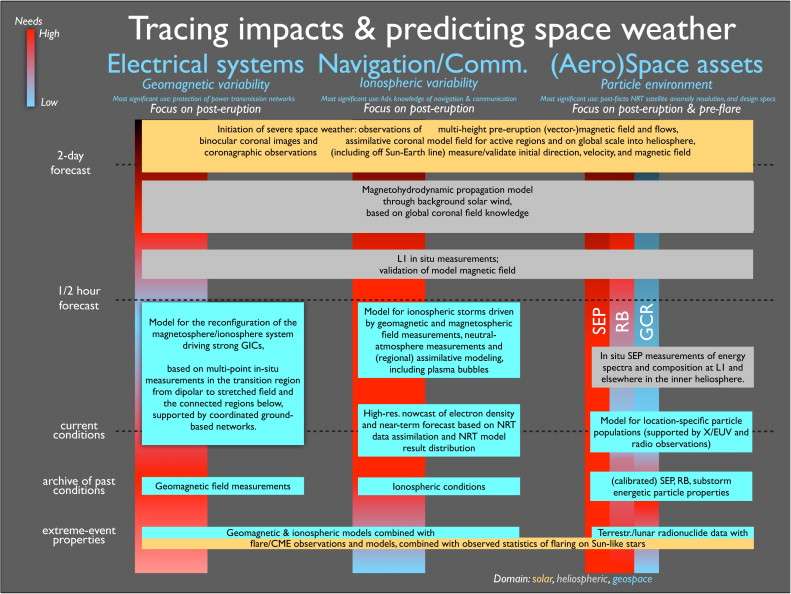July 6, 2015 report
Global roadmap for better understanding space weather released

(Phys.org)—The Committee on Space Research (COSPAR) and the International Living With a Star (ILWS) organization have released a global roadmap for 2015-2025 focusing on better understanding how the phenomena of space weather affect our daily activities on Earth. The strategic plan calls for a coordinated international approach to study the violent solar activity and showcases the research areas that need more attention in order to fully protect our planet from the effects of space weather. The roadmap was published on June 15 in the journal Advances in Space Research.
The authors of the plan strongly emphasize that battling the effects of extreme solar activity is an international challenge. Changes in the sun's magnetic field affect the whole planet, thus worldwide observations and substantial resources are needed to address the problem.
Space weather impacts numerous aspects of our lives, including Earth's climate, satellites, navigation systems, radio communications, and power grid. Severe space storms could result in perturbations in the electric power system and could cause loss of satellites. Therefore, extreme solar events could be catastrophic with severe consequences for millions of people.
"Mitigating against the impacts of space weather can be improved by designing less susceptible, more resilient technologies, combined with better environmental knowledge and more reliable forecasts," the report reads. "This roadmap outlines how we can achieve deeper understanding and better forecasts, recognizing that the expectations for space weather information differ between societal sectors, and that capabilities to observe or model space weather phenomena depend on available and anticipated technologies."
The scientists behind the roadmap recommend the extensive use of current spacecraft in service, which are designed to study the sun's activity. The fleet of active space observatories includes NASA's Solar Dynamics Observatory (SDO) and Japanese Hinode, providing solar magnetic maps. Solar coronagraphy acquired by NASA/ESA SOHO spacecraft and NASA's STEREO probes, is also essential for forecast purposes. Moreover, measurements of the solar-wind plasma and magnetic field delivered by NASA's Advanced Composition Explorer (ACE) satellite and its successor, the National Oceanic and Atmospheric Administration's (NOAA) DSCOVR probe will bring crucial data as well.
These observations made by numerous scientific spacecraft enable estimation of arrival times of the various solar events. For example, huge explosions of magnetic field and plasma from the sun's corona, known as coronal mass ejections (CMEs), can reach Earth in as little as 14 to 17 hours. When CMEs impact the Earth's magnetosphere, they are responsible for geomagnetic storms and enhanced aurorae. In order to predict the strength of the resulting geomagnetic storm, estimates of the magnetic field strength and direction are important. At the present time, the magnetic field cannot be determined until it is measured as the CME passes over a monitoring satellite.
"Ongoing solar missions have given us guidance on optimal solar surface observations to support modeling so that improved estimates on the CME magnetic structure and energy content, as well as the propagation in the heliosphere can be achieved," the researchers wrote in the report.
The main goal is to obtain forecasts more than 12 hours ahead of the magnetic structure of incoming CMEs and their impact in geospace to improve alerts for geomagnetic disturbances.
According to the report authors, ground- and space-based instrumentation should be increased to complement satellite data of the magnetospheric and ionospheric variability to cover gaps.
The roadmap emphasizes the need for coordinated and complementary actions to better shield society from the effects of extreme solar activity. The scientists note that space weather is a real and permanent hazard to our civilizations that needs to be addressed by combining scientific research with engineering ingenuity. The problem should be perceived as still escalating, having in mind that with advancements in technology, society becomes more vulnerable to solar events.
Conclusions from the report promise more accurate space weather forecasting and offer hope of future advancements in the understanding of the solar phenomena. The scientists predict that within the span of the next five to 10 years, we will see major progress regarding our comprehension of these space events and our ability to react to the sun's violent lifecycle.
The Committee on Space Research (COSPAR), established in 1958, is an interdisciplinary scientific body concerned with progress on an international scale of all kinds of scientific investigations carried out with space vehicles, rockets and balloons.
The International Living With a Star (ILWS), established in 2002, is an international organization dedicated to the advancement of space weather science missions and research.
More information: "Understanding space weather to shield society: A global road map for 2015–2025 commissioned by COSPAR and ILWS," Advances in Space Research, Volume 55, Issue 12, 15 June 2015, Pages 2745-2807, ISSN 0273-1177, dx.doi.org/10.1016/j.asr.2015.03.023
(c) 2015 Phys.org





















